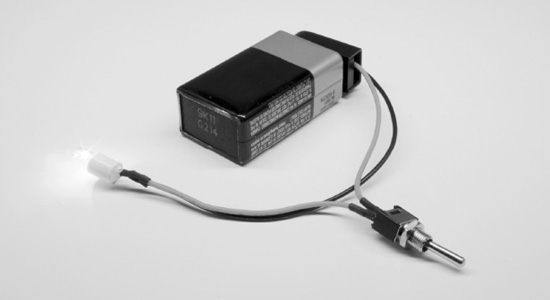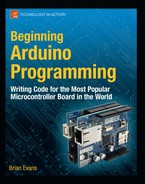Basic Electronics
When we discuss electronics, we are talking about generally small circuits using small amounts of electricity. These circuits handle electricity that is of lesser power by a great margin than that coming out of your wall outlet. Suffice to say, we won't be talking about residential electricity here. Instead we are concerned with small electrical signals used for sending information on the low end, to at the most enough electricity to spin a motor on the high end. To facilitate this conversation, we will start with a basic circuit to build from.
Circuits
The image in Figure 12-1 shows a very simple little circuit.

Figure 12-1. Basic circuit
This circuit has one job: to light up a lamp when the switch is closed. It has all of the prerequisites for a completed circuit that includes a power source, in this case a 9-volt battery, conductors in the form of insulated wires to carry the electricity, a load that resists the flow of current, here an incandescent lamp that produces light and a little heat in the process, and our circuit has a switch to interrupt the flow of electricity at our whim. A power source is needed to provide a source of electricity, whether this comes from the chemical reaction created inside of a battery or the power generated by a power plant down the road. Conductors, copper being an especially good one, send the electricity from the circuit's source to its load and back again, connecting each component to make a completed circuit. Components like our lamp create a resisting load when placed in the circuit that converts our electricity into something else, whether it's light, heat, movement, or so on. Without a sufficient load on the circuit, we would have a short circuit that would cause wires to melt, things to smoke, and other bad things to happen.
That is why it is important to remember two general rules about working with electronic circuits. The first is that electricity will follow the path of least resistance to ground. Accidently place a metal object or extraneous wire across any bare wires in our example circuit and rather than flowing through the lamp, the electrical current will jump through the metal thing instead creating a short circuit. This is also why insulators, materials that do not conduct electricity like plastic and rubber, are used to cover our wires.
The second thing to remember is that the available amount of energy in a circuit must all be used. This is where the smoke and bad things come in because we need to have a power source that matches the load in our circuit. If we accidentally hook the lamp up to 24 volts instead of providing it with a comfortable 9 volts, the lamp will get very bright and very hot for a very short amount of time. And then we won't have a complete circuit because the lamp will have moved on to the big place in the sky for unfortunate components.
Electricity
To make our circuit work we need to have electricity. Electrical current moves in a circle through a circuit from the point of highest potential to the lowest. For the purpose of discussion, in our circuit the current flows from the positive terminal of the battery, through the closed switch, into the lamp to produce light, and is completed when the used up current reaches the negative terminal of the battery. If we were to open the switch by turning it off, we would break the circuit and the electricity will not flow. This kind of flow is an example of Direct Current or DC, where the current flows though a circuit in one direction. DC is common in batteries and those black, little power transformers filling our kitchen drawers. The second way that electricity can flow through a circuit is by Alternating Current or AC. AC reverses polarity at regular intervals, 60 times per second in the US, and is the type of electrical current that comes into our homes and is available from our wall sockets. Figure 12-2 shows a representation of these two different currents.

Figure 12-2. Electrical currents
There are three characteristics about our electrical circuit that are dependent on one another. The first of these is current or the amount of electrical energy that flows through a certain point in our circuit and is measured in amperes or amps. The second characteristic is voltage or the difference in potential between two points in a circuit, sometimes simply referred to as the circuit's electrical energy and is measured in volts. The third characteristic is the resistance placed on our circuit by our load is measured in ohms. The relationship between current, voltage, and resistance has been expressed in Ohm's Law, which can be summarized in the following equation::
Voltage = Current × Resistance
This equation could also be written as the following, depending on which characteristic you would like to solve for:
Current = Voltage ÷ Resistance
or
Resistance = Voltage ÷ Current
Admittedly, this may not be that important to you if all you are doing is hooking up the circuits found in this or other books verbatim, but it could come in handy sometime. Say for example that you buy an LED instead of a lamp to build our basic circuit. The LED itself has very little resistance and might only be rated for +3v at 25 milliamps. If we were to connect the LED straight to the 9v battery, we would have the closest thing to a short circuit and the poor LED wouldn't make it very long. Instead, we need to use a resistor in series with the LED to limit the current flowing through it. Using Ohm's Law, we could solve for this resistance using the following formula:
R = 9V ÷ .025A = 360 OHMS
By dividing 25 milliamps, or .025 amps, into 9 volts, we find that we need a resistor of about 360 ohms to use the entire available amount of energy. Since a 360-ohm resistor might be a little tricky to find, we can use a 330-ohm resistor instead because that's close enough, and close enough works for us. The LED and resistor in this example are two forms of components that are placed in our circuits. Let's look at others.
